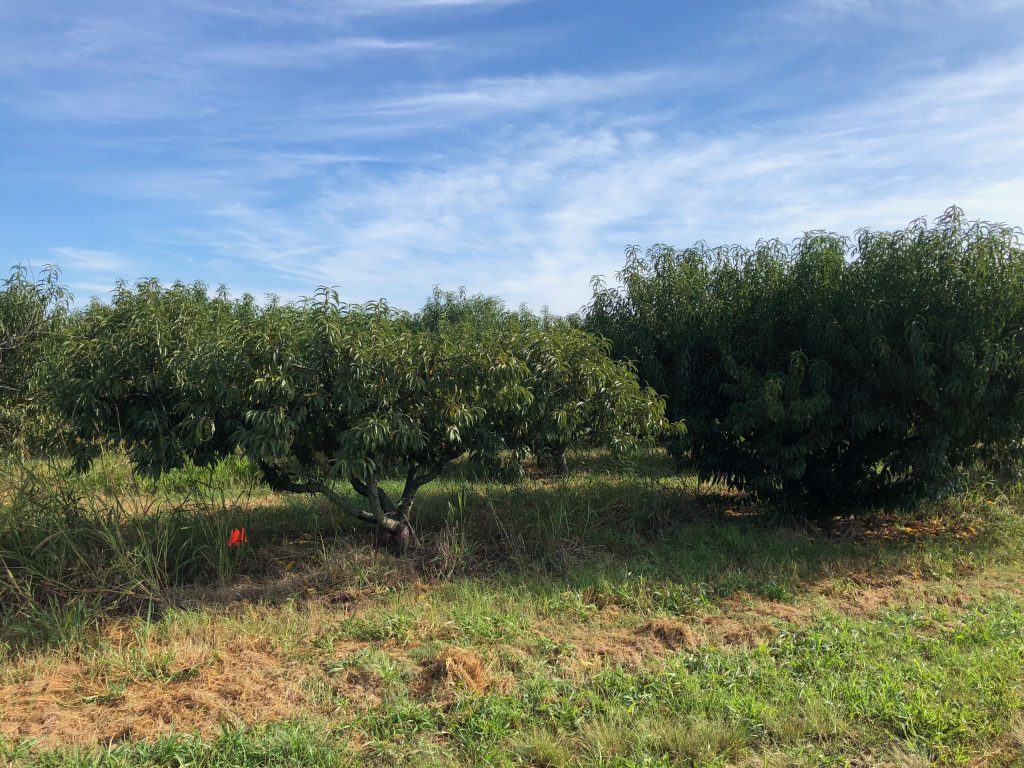By Kendall Johnson and Phil Brannen
Peaches are one of the most economically important fruit crops for the state of Georgia. Growers provide a large variety of high-quality peaches for the fresh market not only in the Southeast, but for much of the United States.

Recently, growers have reported an increase in a disease called phony peach, which threatens production. The disease results in stunted tree growth and lowered fruit quality and quantity. Though the disease has been known for over 100 years, warmer winters may be to blame for increased disease pressure. Recent reports of phony peach sparked the need for additional research to determine disease prevalence and for early-detection methods to limit its development and spread.
Peach trees are plagued by several different diseases throughout the growing season, but this reemerging disease is causing noticeable losses within orchards in Georgia. Phony peach disease, caused by the bacterium Xylella fastidiosa, is an increasingly important disease for the Southeast. Phony peach was first documented in peaches in 1890 near Marshallville, Georgia, and has been a challenge for growers ever since. A few large documented outbreaks were observed following warm winters. The disease is vectored by sharpshooter insects, which are prevalent in warm southeastern climates.
DISEASE DISTRIBUTION AND SYMPTOMS
The geographic distribution of phony peach ranges roughly from North Carolina to Texas and points south, though there are historical accounts of the disease further north. Although the disease occurs throughout the Southeast, it is a significant problem in Georgia due to several factors such as year-round vector activity and greater bacterial survival in the tree. This disease can be one of the primary limiting factors associated with peach orchard longevity.
Phony peach disease causes several symptoms that can be used for identification. However, other causes can mimic these symptoms, which makes accurate identification difficult for the novice. Phony peach symptoms include shortened internodes that can result in a nearly flat leaf canopy on top, dark green foliage and a generally denser and shorter tree. Infected trees also tend to undergo bloom earlier and have a delayed leaf senescence in the fall. Fruit quality is substantially diminished, as phony peach reduces the tree’s ability to produce the equivalent size and number of peaches on healthy trees. Fruit produced from trees infected with phony peach also tends to ripen before healthy peaches.
X. fastidiosa infects peach trees either through root graft transmission or more often through insect-vectored sharpshooter transmission. Bacteria slowly migrate downward from the point of infection through the xylem of the tree. Bacteria tend to set up housekeeping primarily in roots, and it can take more than 18 months before phony peach symptoms develop.
PREVENTION TECHNIQUES
Unfortunately, phony peach is not a curable disease, thus control is directed toward prevention or minimizing spread. To date, the most often used detection method is visual assessment. Growers or consultants walk or drive through orchards and flag trees they think are symptomatic of the disease. In the fall, after phony peach trees have been flagged, they should be rogued to prevent further spread of the disease and to extend the orchard’s productive life.
Additionally, peach orchards should not be planted within 300 yards of host plants, such as wild plums, as leafhoppers could travel from infected plums and further infect a peach orchard. It is therefore also suggested to eradicate wild plums near peach orchards. A good weed control program with a weed-free strip and mowed row middles will help to reduce habitat for the insect vectors that transmit the bacterium.
DETECTION RESEARCH
Various molecular and applied methods are being tested at the University of Georgia (UGA) to determine the prevalence of trees infected with phony peach in Georgia. This is a collaborative effort with Clive Bock and Chunxian Chen at the U.S. Department of Agriculture’s (USDA) Southeastern Fruit and Tree Nut Research Laboratory in Byron, Georgia.
Currently, the lab is collecting different plant tissues from trees to extract DNA and conduct a quantitative PCR (qPCR) protocol for the observation of pathogen presence and quantification. The molecular results are compared to visual disease assessments made by experts in the field. So far, researchers have found that root samples provide the best and most consistent results for DNA quality, quantity and Xylella detection.
Another method being tested is an isothermal DNA amplification and detection system. This method offers several advantages, such as utilization in the field, reduction of detection time and a seemingly more cost-effective approach. However, this method still requires further testing and needs confirmation as a reliable option before suggesting its use to growers or county agents.
Finally, the last detection method involves use of an unmanned aerial vehicle (UAV) with spectral imager. This is a collaborative effort with Glenn Rains at the UGA Tifton campus. The goal is to develop an analytical technique to combine crop stress indices and identify X. fastidiosa infected peaches.
The UAV will take spectral images of the peach orchard with the potential to correlate foliage color and disease presence. Tissue samples from peach plots flown by the UAV will be collected and analyzed using qPCR to determine the presence of the bacterium. Infected plants will be compared to non-infected plants to identify the spectral characteristics of disease symptoms that can be detected from aerial imaging.
Research has already determined that current visual methods are very poor at identifying phony peach disease in the field, as experts can’t accurately identify symptomatic trees, and non-symptomatic trees are often infected. Both UGA and USDA are committed to finding better early-detection methods for phony peach that will allow for the continued success of Georgia’s peach industry, even in the face of changing climate patterns.
Kendall Johnson is a graduate research assistant, and Phil Brannen is an Extension fruit disease specialist — both in the Department of Plant Pathology at the University of Georgia.









